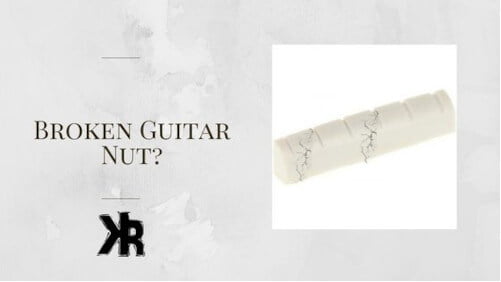Table of Contents
If you’re a musician, then you know that your guitar is a precious instrument. It’s important to take care of your guitar and make sure that all the parts are in good condition.
Especially the nut. The guitar nut is a small piece of hardware located at the top of the neck of the instrument.
If the guitar nut is damaged or broken, it can affect the sound of your instrument as well as its playability.
We recommend that a broken guitar nut gets replaced with a new one. It’s affordable and is better than just repairing the damaged one.
In this Killer Rig article, we’ll show you how to fix a broken guitar nut using simple tools and materials. We’ll also provide some tips for keeping your guitar in good condition.
Broken Guitar Nut
There are many ways a guitar nut can break. The most common way is from material wear and regular use. After some time and many string changes, the material lets go and breaks.
Another way is by accidentally dropping the guitar. Or even hitting it against something hard. This can also cause the nut to break. In most cases, this means a nut slot will no longer hold a string, causing it to be unplayable.
We recommend that a nut be replaced with a new one when it breaks. This can usually be done easily by the owner themselves, or if you prefer a guitar tech can do it. But for best results, replacement is necessary.
Yet, if you are in a pinch and need the guitar to work in a matter of hours, then it’s possible to repair the nut. It then might last until it can be replaced.
How To Fix a Broken Guitar Nut
If you have a broken guitar nut, there are a few things you can do to fix it. The most common thing to do is to use super glue or another type of strong adhesive. Before doing anything, remove the strings around the broken area.
- Clean the area around the broken nut with isopropyl alcohol. This will help the glue adhere better.
- Next, apply a small amount of glue to the broken area. Be careful not to use too much, as it can seep into the nut slots and cause problems later on.
- Press the two pieces of the nut together and hold for a few minutes.
- Once the glue has dried, you can string the guitar and tune it up.
- If the glue is still wet, avoid playing the guitar for a couple of hours.
If there are many pieces that have broken off, try your best to put them back together the way they came off.
Some people use baking soda and superglue. This can build back any missing pieces that might have been lost or cannot be fixed.
Mix the two together and use the mixture to rebuild the nut. You may be required to file some of it out once it has dried, but it should fill in any gaps.
Benefits of Fixing a Broken Guitar Nut
There are several benefits of fixing a broken guitar nut. The most obvious one is that it will restore the playability of your guitar right away.
If you’re a professional musician, then you know that broken guitar nuts can put a damper on gigs.
And always at the worst possible time. It’s important to have a working instrument at all times. Fixing the nut will ensure that your guitar is ready to go in an emergency.
Another benefit of fixing a broken guitar nut is that it can save you money in the long run. Do you have a nut that chips slightly and doesn’t affect the string spacing or performance?
Then it’s easier to just glue it. Not all broken guitar nuts affect the performance of the instrument. Sometimes it is simply aesthetic.
Tips For Keeping Your Guitar Nut in Good Condition
There are a few things you can do to keep your guitar nut in good condition and avoid future breakage.
- Make sure that you’re using the right strings for your guitar. If you’re using heavier gauge strings, then it’s more likely that the nut will break over time. Heavier gauge strings put more tension on the nut slots. This can eventually lead to breakage.
- It’s also essential to make sure that you’re lubricating the guitar nut slots. If you are using a lower-quality material nut, they create friction with the strings. This can lead to poor tuning performance and extra wear to the nut. A dry spray Teflon lubricant can make a big difference.
- Be careful when handling your guitar. Dropping it or hitting it against something hard can easily damage the nut. It can then make it more susceptible to breakage. You might also find that the nut is loose when doing string changes because of impact.
Be careful with your instrument and do proper maintenance. This way, you should be able to avoid any serious damage to the nut.
Conclusion
The most important thing to remember is that a broken guitar nut can be fixed. Whether you decide to do it yourself or take it to a guitar tech.
The process is relatively simple and won’t take too long. It’s also incredibly affordable. This is why replacing a broken nut with a better material is always the best option.
With a little bit of effort, you’ll have your guitar playable in no time.

